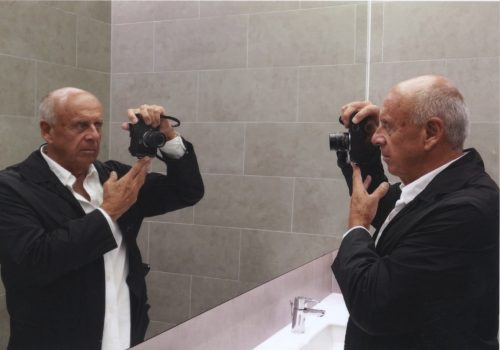The exhibition Ralph Gibson: The Trilogy, 1970–1974, on view at the Pavillon Populaire, culminates Montpellier’s 2017 American photography cycle. From October 18, 2017 to January 8, 2018, this third and final exhibition spotlights Ralph Gibson, a master of abstraction and dramatic, Surrealist effects. The exhibition features the 150 prints comprising his Trilogy: minimalist black-and-white, high-contrast photographs as well as layouts and various documents surrounding the genesis of this monumental work. To accompany the exhibition, The Eye of Photography presents a special edition featuring a brief overview of Ralph Gibson’s career.
Born in 1939 in Los Angeles, the cradle of American cinema, Ralph Gibson is undoubtedly one of the most emblematic figures in American photography. Active between 1960 and 1985, he is also most prolific and most generous in his contribution to the medium. He belongs to a generation I have nicknamed, in a book I devoted to the subject, “the last heroes of photography.”
After a few months’ service in the US Navy, where he trained in photo reproduction, Gibson decided to become himself an artist-photographer. Working as an assistant with the great Dorothea Lange, then with Robert Frank, he realized that he had little interest in documentary or commercial photography. In 1966, he moved to New York, rented a room in the famous Chelsea Hotel, living on a shoestring budget and devoting all his time to taking pictures for a new book of photography. Aimed entirely at presenting the artist’s universe, and driven by a desire to give substance to the Surrealist, oneiric forces toward which Gibson felt himself gravitate, the book would speak in a whole new language.
Influenced by the French Nouvelle Vague, with filmmakers like Jean-Luc Godard and Alain Resnais, and by the Nouveau Roman, with writers like Michel Butor and Alain Robbe-Grillet, Gibson fearing his artist’s book project would be rejected by traditional publishers founded his own publishing outlet, Lustrum Press. He released three volumes, The Somnabulist (1970), Déjà-Vu (1973), and Days at Sea (1974), comprising a set of photographs known today as The Trilogy.
Using groundbreaking layouts, exploring rarely raised themes, developing an autonomous photographic language that bypasses text and aims at self-sufficiency, and characterized by stark contrasts and sumptuous black-and-white, The Trilogy revolutionized the very concept of photobook, inaugurating the age of what has since been known as “Fine Art Photography.” The critical reception of the three volumes propelled Ralph Gibson to the heights of celebrity in a milieu that, with rare exceptions, was more attuned at the time to documentary photography. Larry Clark, Mary Ellen Mark, Daniel Seymour were among photographers who would follow in Gibson’s footsteps, and whose work would be published by Lustrum Press. In Europe, starting with France, artists like Yves Guillot, Arnaud Claass, and Bernard Plossu were also attentive to Gibson’s lessons.
The exhibition Ralph Gibson: The Trilogy, 1970–1974 presents The Trilogy for the first time in its entirety (150 images)—a breakthrough in American photography and in photography publishing. Many of these images have now become landmarks of contemporary photography. Éditions Hazan have reprinted the integral Trilogy in a single volume, preserving the original layouts.
Gilles Mora
Born in 1945, Gilles Mora is a photography historian and critic, specializing in twentieth-century American photography.
The photographs included in this portfolios deliberately highlight Ralph Gibson’s portraits made throughout his career. You will find a selection of images from The Trilogy in a related article devoted to the 1970s.
Ralph Gibson: La Trilogie, 1970–1974
October 18, 2017 to January 8, 2018
Pavillon Populaire
121 Allée de Jerusalem
34000 Montpellier
France
















